Cunard Line
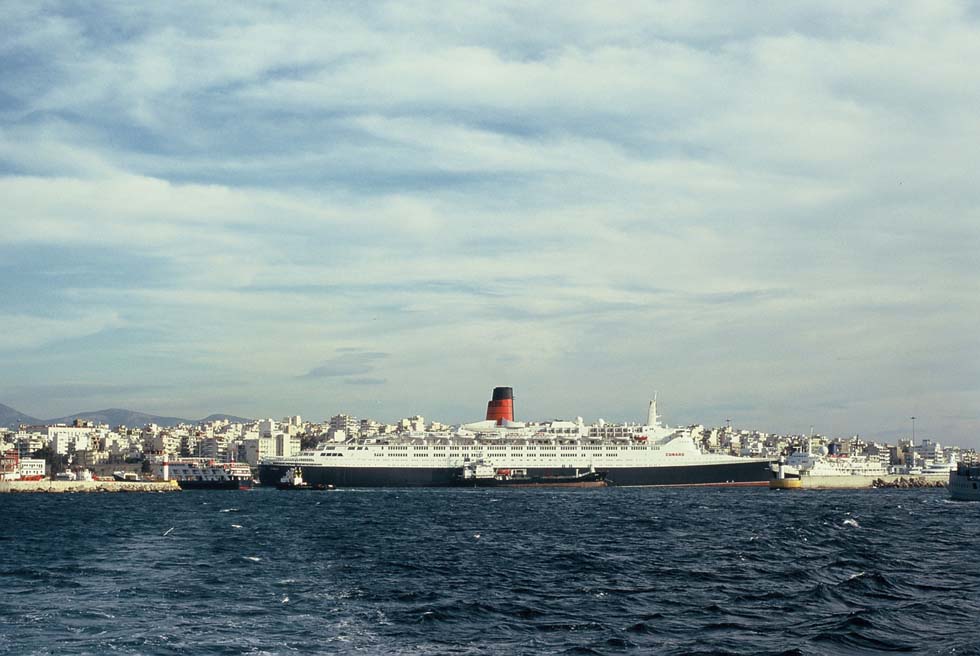
“Queen Elizabeth 2”, Piraeus 2006 (WS)
The Cunard Line, world’s most famous shipping company, employed their most celebrated North Atlantic liners “Queen Mary” (81,237 gt) and “Queen Elizabeth” (83,673 gt) out of season on cruises, the “Queen Mary” departing from Southampton, the “Queen Elizabeth from New York. The Mary, as she was called, left Southampton in 1967 for becoming a hotel at Long Beach. The “Queen Elizabeth”, acquired by C.Y. Tung as a cultural heritage, was destroyed by arson.
The “Caronia”, a steamer of 34,172 gt, launched in 1948, designed for a speed of 22 knots, custom-built for cruises, became renowned for her round-the-world voyages. Painted in shades of light-green, she was known as the “green goddess”. Also other Cunard steamers got that livery, even the “Mauretania” of 1939 on her last cruises. After sale, the “Caronia” became the Italian cruise ship “Columbia”, then the “Caribia” of Universal Line. A heavy explosion in the engine room, by which a man was killed, finished the career of the “Caribia” in 1969. On her last way to Taiwan for scrapping in 1974 she wrecked on the cliffs of Guam in a storm.
With one funnel similar to the “Caronia”, but somewhat smaller was the “Carmania” (22,592 gt, ex “Saxonia”) and her sister “Franconia” (ex “Ivernia”) of 1954-55. In 1973 the “Carmania” and “Franconia” became the Russian “Leonid Sobinov” and “Fedor Shalyapin”. The “Carinthia” (21,947 gt) of 1956 and her sister “Sylvania” of 1957 were sold in 1968 to Sitmar. Renamed “Fairland” and “Fairwind”, they should have taken up Southampton – New Zealand services for Sitmar, but were rebuilt into the cruise ships “Fairsea” and “Sitmar Fairwind”, in 1988 sold to P&O as “Fair Princess” and “Dawn Princess”. Later, all these ships went to the scrapyard.
These newbuilds had been scheduled by Cunard initially for the North Atlantic and from 1967 onward exclusively for cruises. During these years the jetliner achieved the final victory over the ocean liner. Disregarding that reality, Cunard introduced in 1969 the “Queen Elizabeth 2”, a North Atlantic steamer of 65,863 tons, out of season to be employed on worldwide cruises. She was the last ocean liner built by John Brown & Co. A television documentary, broadcasted in the United States in 1980, criticized the QE2 as a “fugitive from modern economic realities running for her very life”, and the magazine Harbour City of Hong Kong had added: “She has probably spent all her life in such a state”. Much later, Frommer’s could reply: “Through sheer persistence, the ship proved the critics wrong, and by the late 1990s she was still going strong, even if the company went through some rough times”.
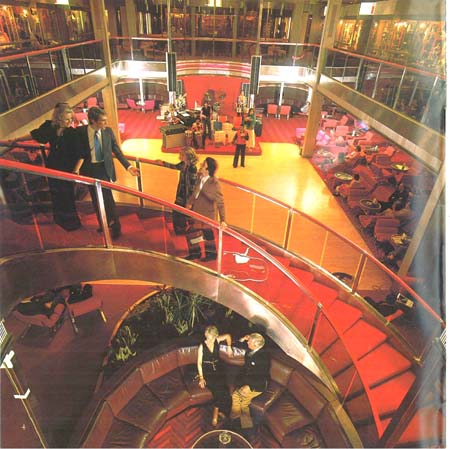
Aboard the “Queen Elizabeth 2” (Cunard ad 1979)
|
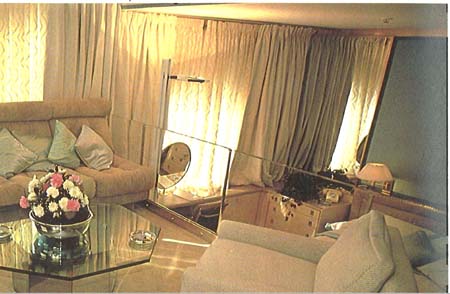
“Queen Elizabeth 2”, a suite (Cunard ad 1979)
|
These rough times were marked by permanent losses, reaching almost 2 million pounds in 1970, and acquisition of Cunard by Trafalgar House Investments in 1971. Among the last fleet additions, introduced exclusively for cruises, appeared the “Cunard Countess” (1976/17,495 gt) and her sister “Cunard Princess” (ex Cunard Conquest”), white with one streamlined funnel, being praised for their beauty. The “Cunard Countess” was used in 1982 during the Falklands War as a trooper, in 1996 she became the “Awani Dream 2” (cruising from Indonesia together with the “Awani Dream”, ex “Renaissance”), then “Olympic Countess” of Olympic Cruises, “Ocean Countess”, in 2005 “Lili Marleen”, cruising for Holiday Kreuzfahrten, in 2006 “Ocean Countess” of Monarch Classic Cruises and in 2007 “Ruby” of Louis Cruise Lines. The “Cunard Princess” served in 1990 temporarily the U.S. Ministry of Defense during the Gulf War and continued her career from 1995 as “Rhapsody” of MSC, in 2009 sold to Mano Cruise of Israel as “Golden Iris”.
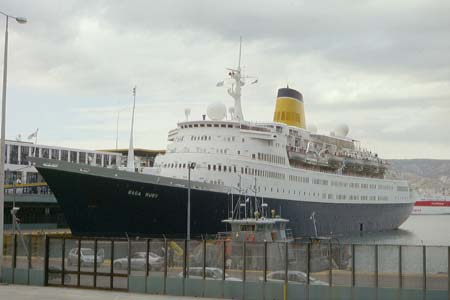
“Saga Ruby”, the former “Vistafjord”, then “Caronia” of Cunard, Piraeus 2007 (WS)
|
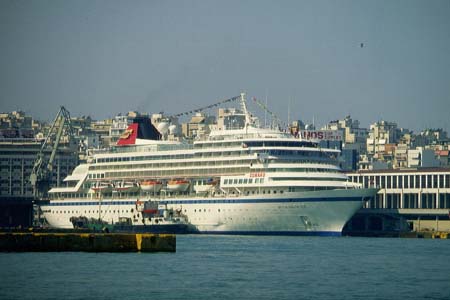
“Royal Viking Sun” of Cunard, formerly Royal Viking Line, Piraeus 1998 (WS)
|
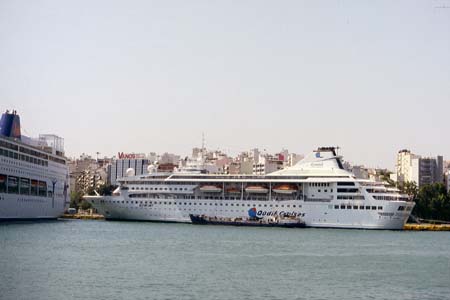
“Gemini” of Quail Cruises, the former “Cunard Crown Jewel”, “Vision Star”, “Superstar Gemini”, Piraeus 2009 (WS)
|
|
In 1983 Norwegian American Cruises was acquired by Trafalgar House, the fleet being fully integrated into Cunard in 1990 (see chapter End of Liners). In 1996 the beautiful “Sagafjord” (1965/24,109 gt) caught fire in the South China Sea, in 1996 she was renamed “Gripsholm” and in 1997 she became the “Saga Rose” of the Saga Shipping Co., founded by Sydney de Haan, in 2004 sold to Charterhouse. The younger “Vistafjord” of 1973 was renamed “Caronia” in 1999. A Cunard brochure of 2003 showed the 24,492 gt ship still in the traditional colours with black hull, white superstructure and red funnel. When in 2004 she went to Saga Shipping as “Saga Ruby”, her funnel paint changed to buff. In the 90s Cunard operated for some time also the smaller “Crown Monarch”, “Crown Dynasty” and the “Crown Jewel” of Crown Cruise Line.
In 1993 Cunard became connected to the Hong Kong Land group without changing the firm’s house colors. The following year Cunard acquired from Royal Viking Line the modern “Royal Viking Sun” (37,845 gt) of 1989. After running aground in the Red Sea in 1996, she was arrested at Sharm El-Sheikh, then repaired at Malta, the funnel being painted red. In 1999 she was renamed “Seabourn Sun”, cruising for Carnival-affiliated Seabourn Cruise Line and in 2002 she was taken over by Holland America Line as “Prinsendam”.
Cunard, at that time in Norwegian hands, continued to produce losses in the 1990s. P&O and also the Carnival Corporation of Micky Arison showed interest in a takeover. Winner was Carnival, which acquired Cunard from the Norwegian company Kvaerner Group in 1998. In 2004, Cunard “… was swallowed whole by Carnival Corporation subsidiary Princess Cruises. Its operations and staff were merged with Princess’s at the latter’s suburban Los Angeles headquarters …”, reported Frommer’s.
During all these difficult decades the “Queen Elizabeth 2” maintained her North Atlantic services and out of season cruises. In 1973, on occasion of the 25th anniversary of the foundation of Israel, the QE2 has undertaken a voyage from Southampton to Haifa with security staff and marines on board, escorted by destroyers and supervised by planes. “Be quiet, Honey, the food is kosher and all around is British”, commented a cartoon by JAK in the Evening Standard. Later the German magazine “An Bord” (5/99) reported: “In mid-1974 an Egyptian submarine had got order (…) to torpedo the ship, for Jews celebrated a big festival on board”. In 1986/87 the QE2 was changed to diesel-electric propulsion. She continued North Atlantic services and the well-to-do passengers could enjoy her classic ambience, the interiors being styled by Dennis Lennon.
Immediately after acquisition of the Cunard Line in 1998, the Carnival Corporation informed the public that they are going to build a new North Atlantic liner, bigger than anything before, the “Queen Mary 2”. That QM2, Micky Arison’s pride, was designed under the guidance of Stephen Payne, the Chief Naval Architect of Carnival. The QM2 was built at Chantiers de l’Atlantique of Alstom at Saint-Nazaire. She is laid out for North Atlantic crossings, with a high deadweight of 19,189 tdw (compared to the 11,132 tdw of Royal Caribbean’s 137,276 gt “Voyager of the Seas”) and she is intended for a 40 years’ career. Additional gas-turbo-electric engines, placed high above the waterline beneath the funnel, and 4 ‘Mermaid’ pods, the two aft ones azymuthing, enable her to achieve a speed of c.30 knots, advantageous to avoid late-running on regular Atlantic crossings. Failures of the pods however led to a lawsuit against Rolls-Royce. For enhanced stability the ship is built completely of steel, the superstructure included. It took five years of design and construction work until the QM2 departed for her maiden voyage in 2004. The ship’s registered size is 148,528 gt according to Kludas and Ships Monthly, but some other source stated 151,400 gt. The interior, designed under guidance of Andrew Collier and also by Robert Tillberg, is sumptuous in a conservative way - representing a Grand Lobby, two promenades leading onto a forward-facing Commodore Club, the ‘Illumination’ planetarium, the Royal Court Theatre, the opulent Queen’s ballroom and many other meeting places. The press praised the menus, inspired by French star chef Daniel Boulud, the Britannia Restaurant echoes the ocean liners’ large dining-rooms of the past, the Todd English Restaurant is an heir to the Verandah Grill of the old “Queen Mary”, the Queen’s Grill Restaurant represents an exclusive refuge for suite passengers. And due to the layout with a wide hull, there is a large outdoor promenade on deck.
The QM2 announces her departure with the low bass note of the steam whistle from the old “Queen Mary”. In 2004 she had her first call at Hamburg, where she received a tremendous welcome. In summer 2004 she berthed at Piraeus on occasion of the Olympic Games, protected there by navy, coast guard and a surveillance airship. In early 2006 the QM2, arriving from Fort Lauderdale, met up with the original “Queen Mary” at Long Beach. Then she returned to New York, both ways round South America, for she is of post-Panamax size. Generally she undertakes regular North Atlantic crossings, the minimum fare (e.g. in 2008) being c.1,800 dollars. And also Caribbean, Canada, Mediterranean, North Sea and around-the-world cruises are on offer.
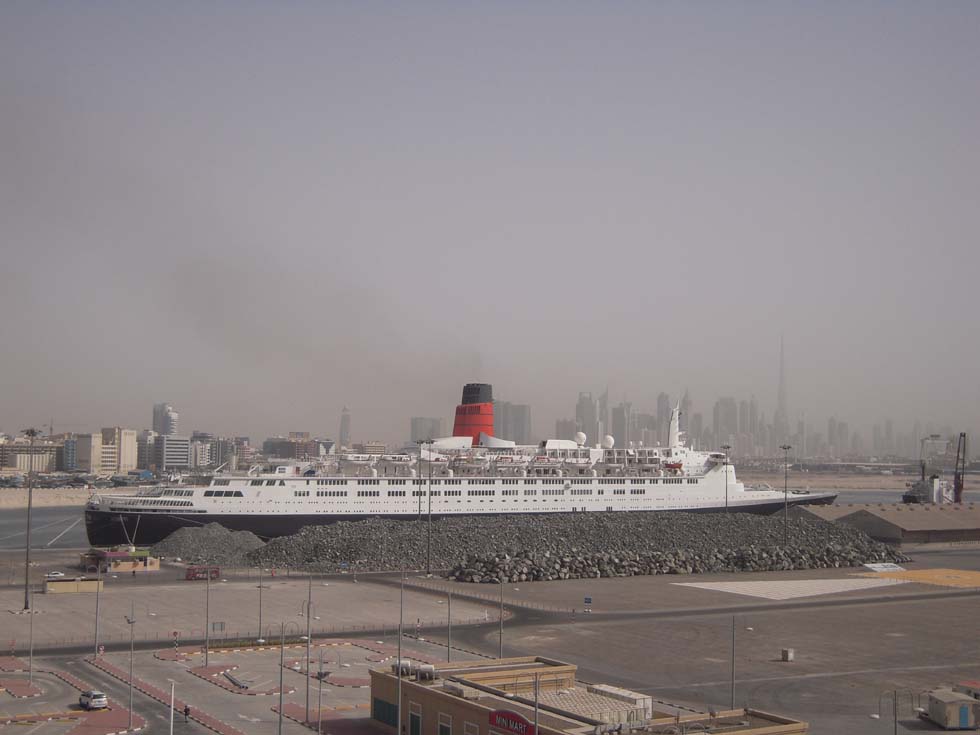
“Queen Elizabeth 2” at Port Rashid, Dubai 2012 (WS)
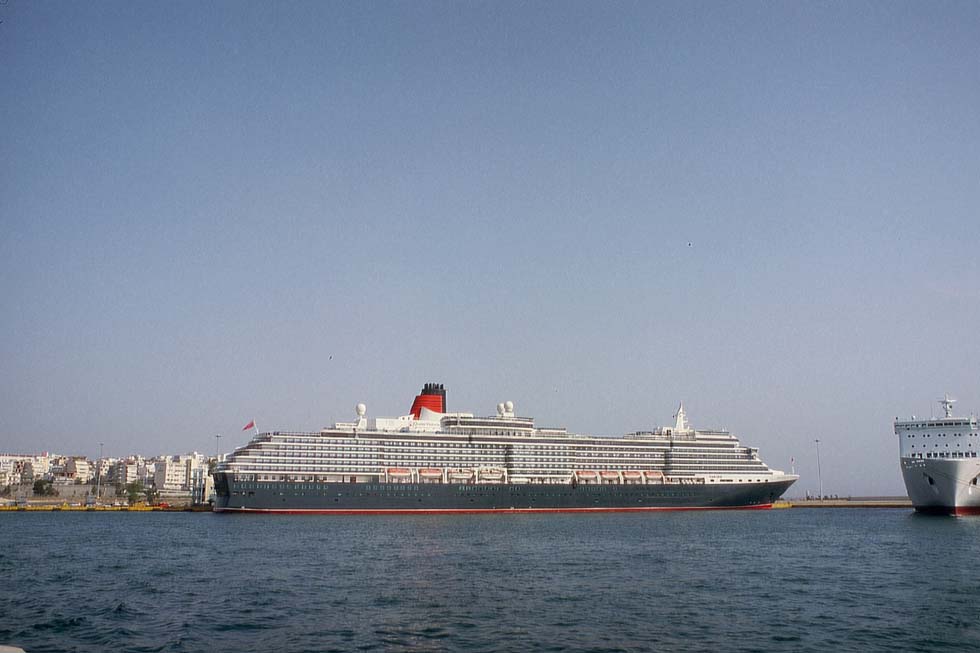
“Queen Victoria”, Piraeus 2008 (WS)
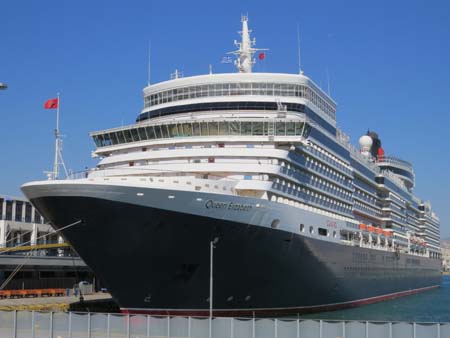
“Queen Elizabeth”, the third, Piraeus 2013 (WS)
|
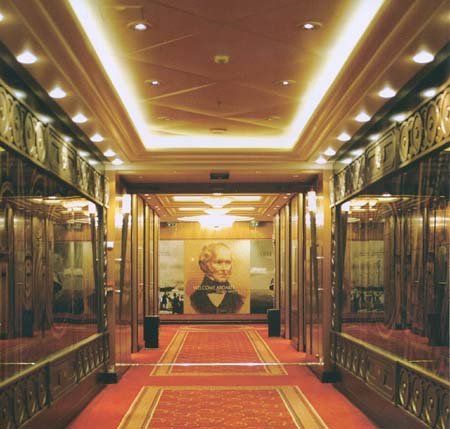
Aboard the “Queen Mary 2” (Cunard advertisement)
|
Soon after the QM2 had been commissioned, the Carnival Corporation announced another new Cunard ship, the “Queen Victoria”, a half-sister of Holland America’s Vista class. Facing the media attention that accompanied the QM2 launch in 2003, the management rethought its decision and ordered a ship of about 90,000 gt, still similar to the Vista class, but without the ‘Oceanview’ elevators and with a very different interior design layout in Victorian style, distinguishing her from the Vista class. The Berlitz Guide and Hansa journal of 2008 described her with pod propulsion, F. Heine and F. Lose with conventional screws. In December 2007 Fincantieri delivered the “Queen Victoria”. After her first world circumnavigation in 2008 she went on European, Caribbean and worldwide cruises.
Still before the “Queen Victoria” was completed, the media published the shocking news, that the “Queen Elizabeth 2” was to be sold to Dubai. After 40 years in service, a farewell passage New York – Southampton was timed for April 2008. Then she was to be refurbished for serving as a hotel and tourist attraction at Palm Jumeirah - and her most faithful passenger, a lady living on board already for nine years and paying 5,000 dollars per month, had to search for a new home. When in 2012 the author has arrived at Dubai (aboard the “Costa Classica”), the “Queen Elizabeth 2” lying there at Dubai’s Port Rashid could have been admired as the last old beautiful North Atlantic liner, illuminated during evening hours.
In October 2007, a few months after the withdrawal of the QE2 had been announced, the Herald Tribune informed: “Carnival, the world’s biggest cruise operator, ordered a new “Queen Elizabeth” ship after selling the iconic “Queen Elizabeth 2” (…). The luxury Cunard Line will begin taking travelers on the 2,092-passenger vessel in 2010”. She is the third ship named in honour of the wonderful Queen – who ever saw the true Queen will never forget her. Like the rather similar “Queen Victoria”, the third “Queen Elizabeth” is based on the design principles of the 1,848-pax HAL Vista class. Featuring a black hull, white superstructure and the black-topped red funnel, both ‘Queens’ are maintaining the company’s traditional and popular appearance.
Newbuilds introduced from 2004:
Queen Mary 2
Chantiers de l’Atlantique, Saint-Nazaire, diesel plus gas-turbo-el., 4 pods (2003/ 148,528 gt).
Vista Class Derivatives
Fincantieri, 2 pods? : “Queen Victoria” (2007/ 90,449 gt); “Queen Elizabeth” (2010/ 90,901 gt).
Despite the excellent reputation of the later newbuilds, the “Queen Mary 2” remains unsurpassed in many aspects. QM2’s four Rolls-Royce Mermaid pods are good for a speed of 32 knots, compared to the 23.7 knots of the “Queen Victoria”. For building the “Queen Mary 2”, the Carnival Corporation had spent almost $1 billion. Compared to the slightly larger “Freedom of the Seas” of Royal Caribbean, the figures are 1bn against 0,7bn, 148,528gt against 154,407gt (according to SM), dimensions 345m (loa) by 41m against 339m by 38.6m, a lower-berth capacity of c.2,600 against c.3,600 passengers, a pax/crew ratio 2.1 to 1 against 2.7 to 1 and average fares e.g. for an outside cabin of $207 against $150 per person per diem (according to Frommer’s Cruises & Ports of Call, in 2007). With her layout for regular North Atlantic crossings and with her deadweight of almost 20,000tdw much heavier than the Freedom class, the QM2’s singular position remains undisputed, probably for decades. She is to maintain the reputation as the real Queen of the oceans.
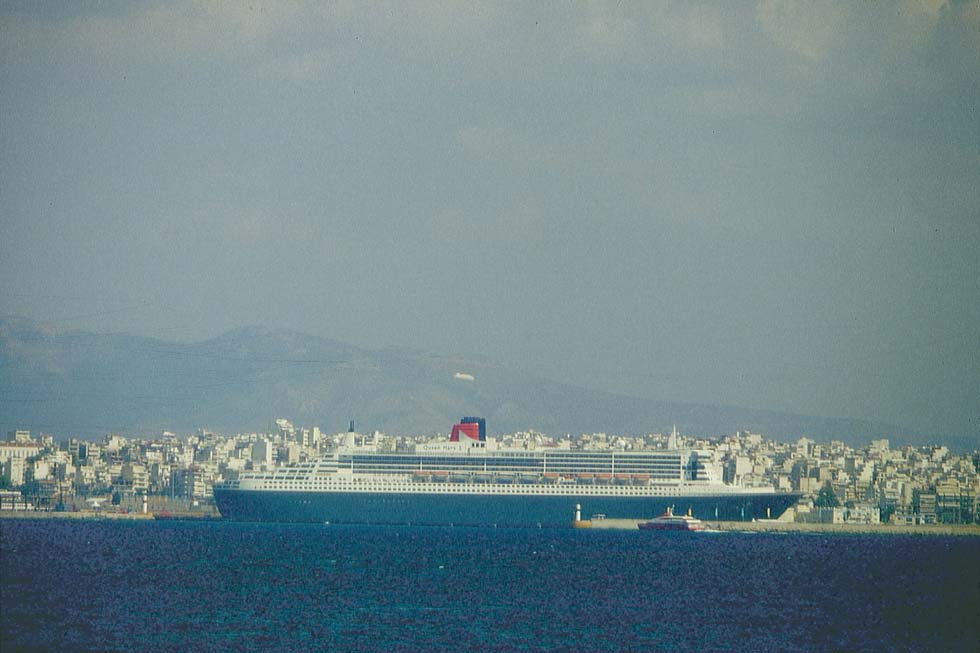
“Queen Mary 2” at Piraeus, under surveillance by an airship during the Olympics of 2004 (WS)
|